A pandemic road trip in a tricked-out Mercedes van
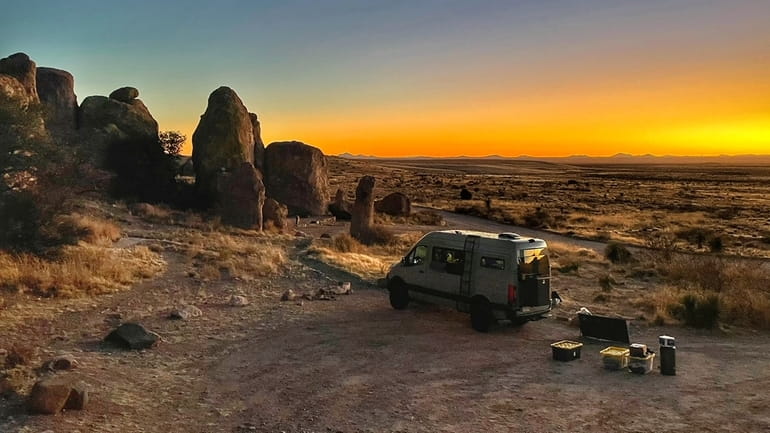
Ronen Yaari of Huntington set out to explore America’s open spaces; here, his camp at City of Rocks State Park in New Mexico. Credit: Ronen Yaari
When writer Jack Kerouac went “On the Road,” it was often in a 1949 Hudson with traveling buddy (and ex-con) Neal Cassady at the wheel.
William Least Heat-Moon had his 1975 Ford Econoline van, in which he perused the off-the-beaten-path “Blue Highways” of America, providing the title for his 1982 bestseller.
A Ford Thunderbird is what Thelma and Louise drove into the sunset in that eponymous 1993 movie.
For road warrior Ronen Yaari, a 63-year-old retiree from Huntington, the vehicle of choice is a 2020 Mercedes-Benz Sprinter van, which he had customized during the pandemic as a solar-powered, eco-efficient and comfortable living space to suit his nomadic, environmentally conscious lifestyle. Yaari dubbed his van Tortuga — the Spanish word for turtle — because, he said, “turtles carry their home on their back, which is kind of what I feel like I’m doing.”
Yaari has been a wanderer since he was a young man — and he has undertaken his journeys by various means of conveyance. He’s biked, hiked, climbed and sailed around much of North America and beyond.
But with Tortuga, which he also describes as his “post-pandemic adventure platform on wheels,” Yaari hopes to drive home an important message on social media about the preservation of public land as well as awareness of environmental illnesses, like the one his new traveling companion has. (She’s a former colleague from Long Island with whom a new romantic relationship was sparked as the odometer turned.)

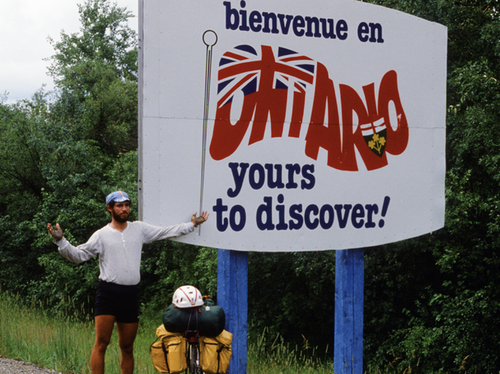

‘LEAP OF FAITH’
All of this has afforded him a different view on things — one demonstrated when he invites a visitor to clamber up the narrow ladder to the roof of Tortuga. Standing 10 feet over his driveway in Huntington (he’s back home for the summer), Yaari points out the array of solar panels and the space on top of the roof rack where, during his travels, he lays out a mat to practice yoga — or just watch the stars.
“This was all a leap of faith,” he said, nonchalantly navigating the perimeter of the open roof as the visitor looked nervously at the concrete below.
Yaari’s leap has propelled him across the country and back three times in the past two years, logging 30,000 miles. It was sparked in 2020, by the pandemic, retirement and the dissolution of his marriage. But his peripatetic inclinations seem a part of his character rooted in his upbringing.
Born in Israel, Yaari spent his childhood in the city of Eilat, on the Gulf of Aqaba. He recalls snorkeling in the Red Sea and joy riding around the nearby Sinai Desert in his dad’s jeep. When he was 11, however, his father, a telecommunications engineer, got a job in New York City. The family moved to Glen Oaks, Queens, and suddenly the scenery changed from the towering peaks of Har Zefahot to the traffic on Hillside Avenue.
“That was quite a trip,” Yaari said dryly.
Still, as he went through high school in Queens and college at Stony Brook University, Yaari’s dual identity — plus the 1970s post-hippie, back-to-the-land ethos then in vogue — gave him a nontraditional view of life and his career.
Or lack of.
As a geology major at Stony Brook (he chose the discipline, he said, because it involved maps and the outdoors), Yaari had the opportunity, upon graduation in 1981, to work for an oil company. The yearly salary would have been $50,000, an enormous amount at that time for a young man. “It would have been a lucrative job, but I chose to travel the world . . . I just wanted to explore and discover,” he said.
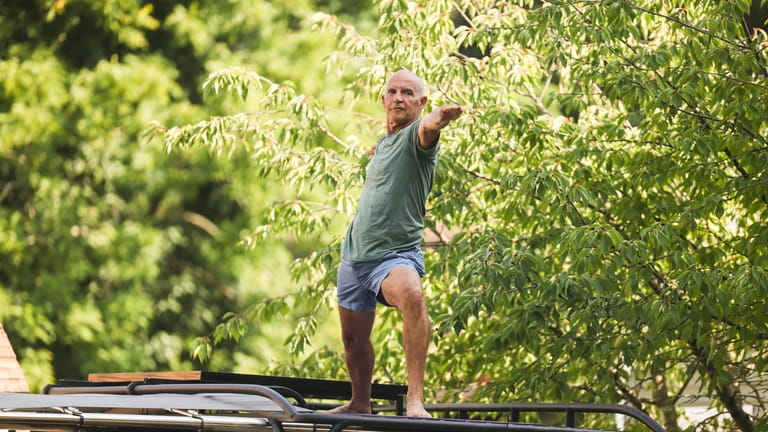
Yaari practices yoga amid the solar collectors on the van's roof. Credit: Newsday/Steve Pfost
He did both during the next decade in a succession of experiences and adventures: He spent a post-grad semester at sea, learning navigation and seamanship on a 100-foot schooner; he worked on a charterboat in the Virgin Islands; he returned to Long Island to help rebuild a historic barn in St. James.
An avid bicyclist, in 1982 he accompanied a friend on a cross-country trip from New York to Berkeley, California. “We took the long way,” he said. Meaning, a 7,000-mile northern route through Canada and down the Pacific Coast. He followed that with a mountain bike ride around the 828-mile Ring Road encircling Iceland.
Next up was a two-month trekking adventure in Nepal with his wife, Elizabeth (a British native he met on a trip back to Israel). Having recently gotten an Apple computer, he documented their travels by creating a website. “Not an easy thing to do in the early ’90s,” he recalled. Soon afterward, he saw an ad for a Manhasset-based publishing company called CMP. It was looking for people to develop websites for its industry trade publications, such as Windows Magazine and Information Week.
He applied — and got the job. For a guy who had never sought a career, it turned out to be a brilliant career move.
“I realized that a lot of the skills you learn on the road, such as improvisation and communication, applied well to the corporate world,” he said. Indeed, Yaari would rise through the ranks at CMP to become editor in chief of Planet IT magazine and editor of Netguide magazine before forming his own company, Open Moves, in 2001. The company was successful enough to allow him to comfortably retire in 2019, when he sold his share of the business.
“I wanted to be in control of my time,” he said. Still, he’s proud that Open Moves is still thriving — and providing a living for 30 employees and their families. “That’s an awesome feeling,” he said.
Not so awesome was the sense of angst he was experiencing during the pandemic lockdown in the spring 2020.
“Wherever I turned there was impermanence,” he wrote in a social media post around that time. After he and his wife parted ways, he decided to “embrace the unknown, court failure and trust that everything’s going to be all right — and if not, I’d figure it out like I did in the old days.”
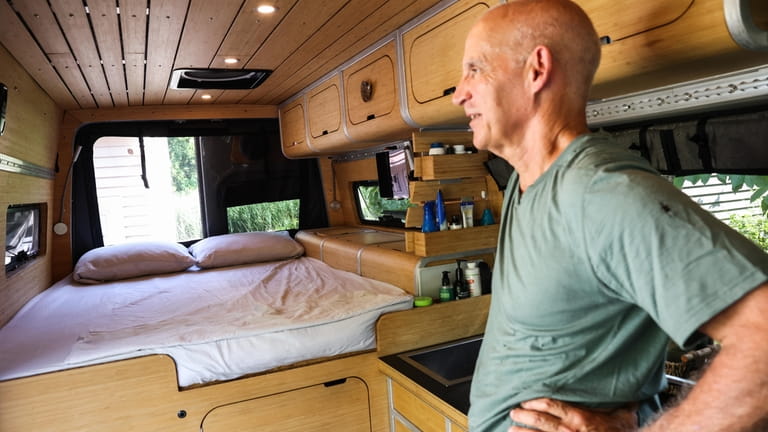
Yaari's van has eco-friendly modifications, including solar panels and a composting toilet. Credit: Newsday/Steve Pfost
VAN MODIFICATIONS
The first thing he had to figure out was his mobile home: Working with the designers at Zenvanz, a Portland, Oregon-based designer and builder of eco-friendly adventure vans, Yaari created a customized vehicle that fit his requirements. “It will brandish a 4 x 4-all-wheel drivetrain, a slide-out rack for mountain bikes and a folding kayak,” he wrote excitedly in a Facebook post just as Tortuga was about to emerge from its shell. “Two-week/off-grid capabilities powered by solar, a big storage battery, and a 20-gallon fresh-water tank. Not to mention, a composting toilet and a hot-
water shower dangling off the back door. The galley will have a solar-powered fridge and an induction stovetop. It will be winterized, insulated and have a heater for the cold nights up north. And maybe just enough space for a yoga cushion on the roof rack amidst the solar farm.”
Yaari’s decision to take to the open road in an environmentally conscious way was hardly a shock to his son, Oren, one of three children, all in their 20s. “This seemed very on brand for my dad,” said Oren, 23. “He’s really a deep thinker, and he cares about how he walks through the world.”
Or drives, in this case. Oren, a student at Hunter College when his dad headed to Portland to pick up the van, went with him. “Since my classes were all on Zoom, I decided to do a portion of my semester from the van,” Oren said.
It turned out to be a wonderful experience. “We would park in these remote, pristine areas, explore the land,” he said, “but you’d have the comforts of home back in the parking lot.”
After Oren returned home, his dad continued to explore public lands in Utah, Arizona and other Western states. Yaari began chronicling his travels on social media, regaling his 1,300 Facebook friends with insights into the parks and preserves he visited.
And then, in late 2020 — on his second trip back across country in Tortuga, the story took a twist. He learned that a former business colleague from Sayville was living in Silver City, New Mexico. Tina Annibell had moved there in 2019 to help her combat environmental illnesses, including one caused by mold, for example, which Yaari also writes about on social media. The interior of Tortuga, constructed using as few industrial paints, sealants and adhesives as possible, proved to be a place where she could quite literally breathe easy. “It was little short of a miracle,” she said.
Yaari and Annibell became a couple — and during the past year and a half have made their way around the country together, alternating brief periods in Huntington with months on the road, typically spending about a week at each place they stopped.
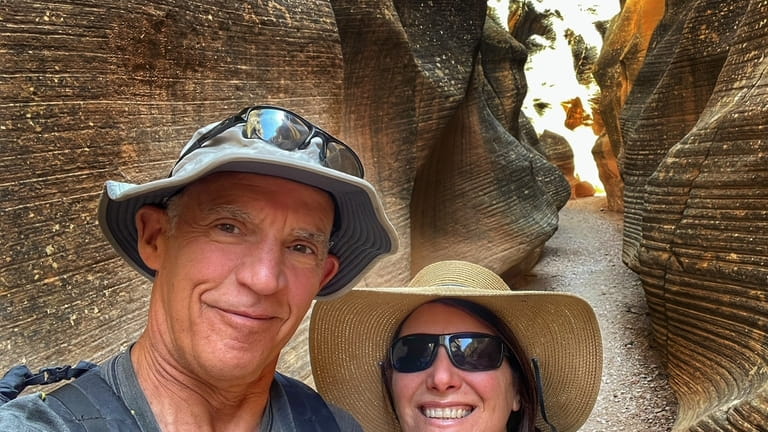
Yaari and travel companion Tina Annibell hike at Little Wild Horse Canyon, Utah. Credit: Ronen Yaari
‘RUGGED PLACES’
“It’s a great lifestyle, being able to go to these beautiful and rugged places,” Annibell said. “No people, no traffic, no noise.” And with an adventurous but supportive soul next to her, she said, “There’s a lot of trust and teamwork.”
While they’re enjoying their travels on Tortuga, neither Yaari nor Annibell are looking far into the future. Which is certainly consistent with Yaari’s philosophy.
“I feel like I have a new pathway,” he said. “It involves raising awareness of these public lands, and the ability to move.”
He pauses, as he looks over at Tortuga. “Mobility,” he said. “That’s the key.”
Kerouac would agree.
Venturing onto public lands
Ronen Yaari’s post-retirement travels in America are focused on public lands, which go far beyond the major national parks, such as Yellowstone or Yosemite. According to the U.S. Department of the Interior, public lands comprise 400 national parks, 560 national wildlife refuges and nearly 250 million acres in other categories, including national forests, trails and historic sites. Visit doi.gov/blog/americas-public-lands-explained.
A number of not-for-profit organizations have emerged to help with preservation and stewardship of these lands. Here are some that Yaari recommends to those interested in learning more: grandcanyontrust.org, conservationlands.org and friendsofcedarmesa.org.
Yaari also chronicles, in text and photos, his ongoing adventures and travels to public lands. Follow him on Facebook at facebook.com/openmoves and Instagram @Ronen_Yaari.
